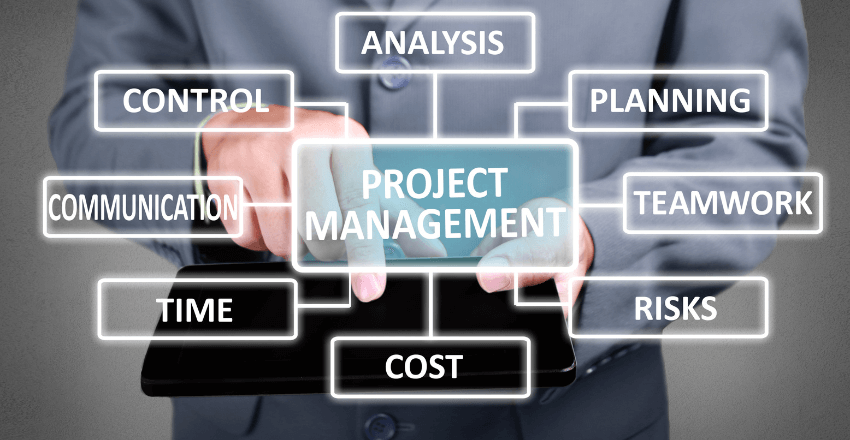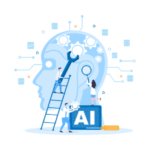
Management Tips for an AI Development Project: Steer your future with precision by mastering the art of intelligent leadership.
Managing an AI development project can be challenging, but effective management is crucial for achieving successful outcomes.
In this article, we will provide essential management tips for AI development projects that can help you set clear goals, build a skilled and diverse team, foster communication and collaboration, establish a robust project management structure, monitor progress, mitigate risks, and foster a culture of continuous learning and improvement.
Set Clear Project Goals and Objectives
Defining clear goals and objectives is key to a successful AI development project. Without specific targets, it can be challenging to measure progress and ensure alignment with the organization’s overall strategy.
When setting goals and objectives for an AI project, consider the following tips:
- Be specific: Clearly define what you want to achieve, how you plan to do it, and what success will look like.
- Make them measurable: Establish metrics for tracking progress and use data to evaluate success and identify areas for improvement.
- Ensure alignment: Goals and objectives should align with the organization’s overall strategy and values to ensure the project contributes to the company’s long-term success.
It’s also important to communicate goals and objectives to the project team and relevant stakeholders. This can help ensure everyone is working towards the same objectives and understands the project’s purpose.
By setting clear goals and objectives, AI development projects can stay focused, measure progress, and achieve successful outcomes.
Build a Skilled and Diverse Team

Assembling a skilled and diverse team is crucial to the success of any AI development project. Hiring professionals with a variety of backgrounds, experiences, and skills not only increases the team’s creativity and innovation but also enhances the quality of the final product.
When building your team, consider recruiting professionals with expertise in fields such as computer science, mathematics, and engineering.
However, it’s also important to seek out candidates with diverse perspectives, including individuals from different ethnic, racial, and gender backgrounds, as well as those with non-traditional educational or professional paths.
Keep in mind that building a diverse team is only the first step. It’s also essential to foster an environment that encourages collaboration and inclusivity. Provide opportunities for team members to share their ideas and perspectives, and ensure that everyone feels valued and included in the decision-making process.
Strategies for Building a Skilled and Diverse Team
| Strategy | Description |
|---|---|
| Partner with educational institutions | Partner with universities or coding boot camps to recruit diverse and talented candidates. |
| Offer internships and mentorships | Provide opportunities for students or professionals from underrepresented groups to gain experience and mentorship in AI development. |
| Provide ongoing training and development | Invest in ongoing training and development programs to ensure that team members have the skills they need to succeed. |
By building a skilled and diverse team and fostering a collaborative and inclusive environment, you can ensure that your AI development project is primed for success.
Establish a Robust Project Management Structure

Effective project management is crucial for the success of any AI development project. To ensure that the project is completed within the allocated timeframe and budget, it is essential to establish a robust project management structure that outlines the roles, responsibilities, and decision-making processes.
A project management structure should provide a clear roadmap for the development process, including the various stages of the project, timelines, and milestones.
By implementing a structured approach, team members can work collaboratively, minimize the risk of errors, and ensure that the project delivers the desired outcome.
Identifying Project Management Methodologies
Choosing the right project management methodology is essential for managing an AI development project successfully. There are various project management methodologies available, including agile, waterfall, and hybrid methods.
Agile methodologies focus on iterative, flexible development, where teams work in short, collaborative sprints. Waterfall methodologies, on the other hand, follow a linear approach, with sequential stages of development.
Hybrid methodologies combine elements of both agile and waterfall methodologies, with a focus on flexibility and adaptability.
Each methodology has its benefits and drawbacks, depending on the specific project requirements and goals. It is crucial to identify the most suitable methodology for the project and tailor it accordingly.
Defining Roles and Responsibilities
Assigning clear roles and responsibilities is critical for successful project management. Each team member should have a clearly defined job scope and responsibilities, which help to minimize confusion and ensure accountability.
Additionally, a project sponsor should be identified to provide guidance and support to the team, while a project manager should be appointed to monitor and track progress and ensure that the project stays on track.
By defining roles and responsibilities, the team can work efficiently and effectively to achieve the project’s objectives.
Establishing Decision-Making Processes
Establishing clear decision-making processes is critical for managing an AI development project successfully. Decisions related to the scope, timelines, and budget should be made by the project sponsor and project manager, while more technical decisions should be made by the development team.
By establishing clear decision-making processes, the team can avoid delays and confusion and ensure that the project stays on track. It is also essential to ensure that team members have the necessary authority and resources to make informed decisions during the development process.
Overall, a robust project management structure is critical for managing an AI development project successfully.
By identifying the most suitable project management methodology, defining clear roles and responsibilities, and establishing decision-making processes, the team can work collaboratively and efficiently to achieve the desired outcomes.
Set Realistic Timelines
Setting realistic timelines is an essential part of project management. It is important to identify milestones and deadlines and to communicate them to the team. This helps ensure that everyone is aware of the project timeline and can plan their work accordingly.
However, it is also important to be flexible when necessary and to adjust the timeline as needed to account for unexpected issues or changes in project scope.
Use Collaborative Tools
There are a variety of collaborative tools available that can help with project management. These tools allow team members to communicate and share information in real-time, no matter their location.
Some popular project management tools include Trello, Asana, and Slack. Using these types of tools can help streamline communication and collaboration, increase productivity, and help ensure that everyone is on the same page.
Track Progress and Make Adjustments as Needed
Regularly tracking progress and making adjustments as needed is an important part of project management. This includes monitoring project milestones, identifying potential bottlenecks, and making adjustments to ensure the project stays on track.
It is also important to conduct regular team meetings and communicate any issues or changes to the team as soon as possible.
By implementing a robust project management structure, you can help ensure the success of your AI development project.
By defining clear roles and responsibilities, setting realistic timelines, using collaborative tools, and tracking progress, you can keep your project on track and ensure that it meets your desired outcomes.
Monitor Progress and Adapt as Needed
Effective monitoring of progress and timely adaptations are crucial to a successful AI development project. It is important to continuously track the project’s progress, identify potential bottlenecks, and make necessary adjustments to the development process.
Here are some tips to help you monitor progress and adapt as needed:
Track Milestones
Establish clear milestones and timelines for deliverables, and track progress regularly against those goals. This will help you identify any areas that may need additional focus or resources, and allow you to adjust the development process accordingly.
Identify Potential Bottlenecks
Monitor the development process closely to identify any potential bottlenecks that may slow down or impede progress.
For example, if there is a delay in obtaining access to necessary data, this could cause a bottleneck in the development process. Be proactive in identifying and addressing such bottlenecks to keep the project moving forward.
Make Adjustments as Needed
If progress is not meeting expectations, or if you identify potential bottlenecks, adjust the development process as needed. This could involve reallocating resources, shifting timelines, or modifying project goals. Be prepared to make these adjustments quickly and efficiently to keep the project on track.
Implement Agile Methodologies
Consider implementing agile methodologies such as Scrum or Kanban to help manage the development process and facilitate adaptability.
These methodologies emphasize regular communication and collaboration, allowing teams to quickly identify and adapt to changing project requirements and priorities.
By monitoring progress and making necessary adaptations, you can keep your AI development project on track and ensure successful outcomes. Be proactive in tracking milestones, identifying bottlenecks, and making adjustments to the development process as needed.
Mitigate Risks and Address Ethical Concerns
As with any technology project, AI development carries its share of potential risks and ethical concerns. To ensure the success of your project and its responsible implementation, it is crucial to identify and mitigate these risks and address any ethical concerns that may arise.
Risk Assessment
Conducting a comprehensive risk assessment is a critical step in managing an AI development project.
It involves identifying potential risks and evaluating their likelihood and potential impact on the project. Some common risks associated with AI development projects include technical failures, data breaches, and legal and regulatory compliance issues.
To mitigate these risks, consider implementing risk management strategies such as regular testing and quality assurance, establishing data security protocols, and staying up-to-date with applicable laws and regulations.
It is also important to have contingency plans in place in the event of unexpected issues or setbacks.
Ethical Concerns
As AI technologies become more advanced, there is growing concern about their potential impact on society, including issues related to privacy, bias, and employment. To ensure that your AI development project is ethically responsible, it is essential to address these concerns from the outset.
One way to do this is by establishing an ethical code of conduct for your project team, outlining principles such as transparency, fairness, and accountability.
It is also important to consider the potential social and economic impacts of your project and to engage with stakeholders to understand and address any concerns they may have.
Ultimately, managing the risks and ethical considerations associated with AI development requires a proactive and collaborative approach.
By taking these issues seriously and implementing effective strategies to address them, you can help ensure the success of your project while upholding ethical and social responsibilities.
Foster a Culture of Continuous Learning and Improvement
Continuous learning and improvement are essential for managing an AI development project successfully. Your team must be open to experimentation, willing to innovate, and embrace feedback to enhance the project outcomes.
Here are some tips for fostering a culture of continuous learning and improvement on your AI development project:
- Encourage collaboration and knowledge sharing: Encourage your team to work collaboratively and share knowledge, ideas, and best practices freely.
- Offer development opportunities: Provide your team with opportunities to learn new skills, attend conferences, and participate in professional development activities.
- Celebrate successes: Celebrate team successes, and recognize individual and team accomplishments to motivate your team and encourage a positive culture.
- Embrace experimentation: Encourage your team to experiment with new approaches, methodologies, and technologies.
- Emphasize data-driven decision making: Encourage your team to use data to make informed decisions, track progress, and evaluate outcomes.
By fostering a culture of continuous learning and improvement, you can help your team stay motivated, engaged, and committed to delivering the best possible outcomes for your AI development project.
Frequently Asked Questions about Managing an AI Development Project

Managing an AI development project requires a unique set of skills and best practices to ensure success. Here are some common questions and answers that may help you navigate the process.
What are some common challenges in managing an AI development project?
Some common challenges include accurately defining project goals, assembling a skilled and diverse team, implementing effective communication strategies, monitoring progress, mitigating risks, and addressing ethical concerns related to AI technologies.
What are some best practices for building a skilled and diverse team for an AI development project?
Some best practices include proactively identifying and recruiting individuals with diverse backgrounds and skill sets, fostering an inclusive work environment, and providing opportunities for professional growth and development.
How can I ensure effective communication and collaboration among team members?
Establishing open lines of communication, promoting knowledge sharing, and implementing collaborative workflows are essential for effective communication and collaboration.
It’s also important to establish clear roles, responsibilities, and decision-making processes to minimize confusion and promote productivity.
What are some common project management methodologies for AI development projects?
Some common project management methodologies include Agile, Waterfall, and Scrum. It’s important to select a methodology that aligns with the project’s goals and objectives, and to establish a clear project management structure that includes timelines, milestones, and contingency plans.
How can I mitigate risks and address ethical concerns related to AI technologies?
Conducting thorough risk assessments, implementing risk management strategies, and addressing potential ethical concerns through transparent and responsible development practices are critical for mitigating risks and addressing ethical concerns related to AI technologies.
How can I foster a culture of continuous learning and improvement among team members?
Encouraging experimentation, embracing feedback, providing opportunities for professional growth and development, and promoting knowledge sharing are all effective ways to foster a culture of continuous learning and improvement among team members.
We hope this FAQ has been helpful in answering some of your questions about managing an AI development project. If you have any further questions or concerns, feel free to seek out additional resources or consult with industry experts in the field.
Jane Watson is a seasoned expert in AI development and a prominent author for the “Hire AI Developer” blog. With over a decade of experience in the field, Jane has established herself as a leading authority in AI app and website development, as well as AI backend integrations. Her expertise extends to managing dedicated development teams, including AI developers, Machine Learning (ML) specialists, and other supporting roles such as QA and product managers. Jane’s primary focus is on providing professional and experienced English-speaking AI developers to companies in the USA, Canada, and the UK.
Jane’s journey with AI began during her time at Duke University, where she pursued her studies in computer science. Her passion for AI grew exponentially as she delved into the intricacies of the subject. Over the years, she honed her skills and gained invaluable experience working with renowned companies such as Activision and the NSA. These experiences allowed her to master the art of integrating existing systems with AI APIs, solidifying her reputation as a versatile and resourceful AI professional.
Currently residing in the vibrant city of Los Angeles, Jane finds solace in her role as an author and developer. Outside of her professional pursuits, she cherishes the time spent with her two daughters, exploring the beautiful hills surrounding the city. Jane’s dedication to the advancement of AI technology, combined with her wealth of knowledge and experience, makes her an invaluable asset to the “Hire AI Developer” team and a trusted resource for readers seeking insights into the world of AI.







